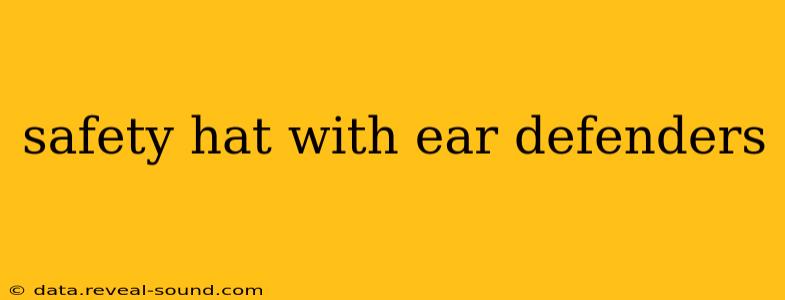Working in noisy environments presents significant risks to both hearing and head safety. Combining a safety helmet with ear defenders provides crucial protection against these hazards, preventing serious injuries and long-term health problems. This comprehensive guide explores the importance of this combined protective equipment, factors to consider when choosing the right one, and best practices for its use.
What are the Benefits of Using a Safety Hat with Ear Defenders?
Using a safety hat with integrated earmuffs or a compatible helmet and ear defender combination offers numerous benefits:
-
Dual Protection: This is the most significant advantage. It protects your head from falling objects, impacts, and electrical hazards while simultaneously safeguarding your hearing from damaging noise levels. This integrated approach simplifies safety procedures and ensures consistent protection.
-
Increased Productivity: Workers who feel safe and protected are more likely to be focused and productive. Knowing they have adequate head and hearing protection minimizes distractions and anxieties associated with workplace hazards.
-
Reduced Risk of Injury and Long-Term Health Issues: Head injuries can be devastating, while prolonged exposure to loud noises can lead to permanent hearing loss, tinnitus, and other auditory problems. A combined safety hat and ear defender significantly reduces the risk of both.
-
Compliance with Safety Regulations: Many industries have strict regulations regarding hearing and head protection in noisy environments. Using a combined system ensures compliance and reduces the risk of penalties or legal issues.
-
Improved Comfort and Usability: Modern safety helmets with integrated ear defenders are designed for comfort and usability, minimizing discomfort during prolonged wear. This improves worker acceptance and ensures consistent use.
What Types of Safety Hats with Ear Defenders are Available?
Several options cater to diverse needs and preferences:
-
Integrated Ear Defenders: These helmets have earmuffs built directly into the helmet design. This provides a streamlined and secure fit, minimizing movement and potential gaps.
-
Attachable Ear Defenders: These are separate ear defenders designed to be easily attached to standard safety helmets. This offers flexibility, allowing users to choose their preferred helmet and ear defender combination.
-
Different Materials and Designs: Helmets and ear defenders are available in various materials, including ABS plastic, fiberglass, and polycarbonate, each offering different levels of protection and weight. Design features vary, offering different levels of comfort, adjustability, and ventilation.
How to Choose the Right Safety Hat with Ear Defenders?
Selecting the appropriate safety hat with ear defenders involves several key considerations:
-
Noise Reduction Rating (NRR): This rating indicates the level of noise reduction provided by the ear defenders. Higher NRR values provide better protection in louder environments.
-
Helmet Impact Resistance: Ensure the helmet meets relevant safety standards and provides adequate protection against impact forces.
-
Comfort and Fit: The helmet should fit snugly and comfortably without causing discomfort or restricting movement.
-
Compatibility: If purchasing separate components, ensure the ear defenders are compatible with your chosen helmet.
-
Environmental Factors: Consider environmental conditions such as temperature, humidity, and potential exposure to chemicals when selecting materials.
What are the Different Standards for Safety Hats with Ear Defenders?
Safety hats and ear defenders are often subject to specific standards depending on the region and industry. Always verify that the equipment meets the relevant standards for your workplace. Common standards include:
- ANSI Z89.1 (US): This standard covers head protection.
- EN 397 (Europe): This standard specifies requirements for industrial safety helmets.
- EN 352 (Europe): This standard covers hearing protectors.
How to Properly Wear a Safety Hat with Ear Defenders?
Proper fit and usage are crucial to ensure effectiveness:
-
Adjust the Helmet: The helmet should fit snugly but not tightly, allowing for comfortable movement and preventing slipping.
-
Position the Ear Defenders: Ensure the earcups completely cover the ears and create a good seal.
-
Regular Inspection: Regularly inspect the helmet and ear defenders for any signs of damage or wear and tear. Replace damaged equipment immediately.
What are the Maintenance Requirements for Safety Hats with Ear Defenders?
Regular maintenance ensures prolonged functionality and safety:
-
Cleaning: Regularly clean the helmet and ear defenders as per the manufacturer's instructions.
-
Inspection: Inspect for any cracks, damage, or deterioration of materials.
-
Replacement: Replace the equipment at the manufacturer's recommended intervals or if damage is detected.
This guide provides a comprehensive overview of safety hats with ear defenders. Remember to consult safety professionals and refer to relevant standards and manufacturer guidelines to ensure appropriate selection and use for optimal protection in your specific workplace. Prioritizing both head and hearing safety contributes significantly to a safer and healthier work environment.
